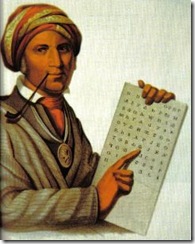Adam Blatner
Words and Images from the Mind of Adam Blatner
The Roots of My Interest in Scriptology
Originally posted on February 19, 2011
I’ve been making a series of presentations about scriptology, the very inter-disciplinary not-yet-officially formed field that deals with writing and associated technologies. It has been a sort of hobby of mine since the early 1970s, though I now realize that I’d been somewhat sensitized to the whole enterprise through a number of blessings (as I call them), including these:
– I had time to play, fantasize, and a nice home and neighborhood where I could do it.
— People didn’t invade my mind too much, filling me with a lot of taboos. Some, perhaps, but not a lot.
– Maybe because I was a bit sickly as a kid, less athletic, somewhat nearsighted, so I channeled my exploratory instincts into the possibilities afforded by art.
– Comic books were big in my childhood in the 1940s and early ‘50s; also radio, and “secret code rings” used by Captain Midnight and other crime-fighters
– I was raised in a semi-assimilated Jewish home. (I’ll explain that in another blog.) I was expected to learn how to read some Hebrew for the Passover prayers. I also attended some after-school classes, was finally Bar Mitzvah’d, but then pretty much dropped it. But there was the experience of encountering not just another language, but a foreign alphabet. And the ways Hebrew works, reading from right to left, the way the attached vowels—if they did—and other things impressed me: All language and writing was not done the same way! What was that about? Well, okay, codes were around and so I just treated it as if it were another sort of a code. I learned to read the letters, to sound them out, but hardly learned the language itself.
– Yiddish was another thing—you spoke something that was a little like German, which was also weird because in the mid-1940s the Germans were the bad guys—but anyway it didn’t count because you wrote Yiddish in a kind of Hebrew—especially in its cursive form. (Later I found out there were newspapers written in the same square script as what was found in my prayer books—they had whole newspapers with this odd writing.)
– I saw occasional examples of the exotic writing that expressed Japanese and Chinese—but, sorry, for a kid back then they all looked alike to me. Exotic Arabic, too, was just over the edge of my perception. But I sensed there were alternatives to the good ol’ English. Later I found out that you used English letters to write in French! Weird! (And much later I learned that the writing system for English was really based on the ancient Roman script, which could be used to write a good many foreign languages. And there was Russian—yet another funny script—not as odd as Chinese, but it was Greek to me (ha ha). Then I found out about ancient Greek.)
– Approaching later childhood, I discovered there were also abbreviations for the chemical elements, and abbreviations, and funny signs on the typewriter for who knows what—@ # $ % & * … it was fun finding out what they meant, and learning about all kinds of other symbols.
– It was fun making these symbols, from Alchemy (which sort of went with the odd abbreviations for Elements, which did not always fit the names, so that, silver had the sign Ag), and from astrology, and mathematics, and on maps..
– Oh, yeah, meanwhile I started piano lessons. They were pretty common in the 1940s if you could afford it. Reading music: another code system!
– I played with making up language sounds, speaking gibberish with some friends who enjoyed a bit of goofiness, pretending we could talk Russian in elevators, as if we were spies—early adolescent stuff.
It’s sort of fun to think of how many factors came together to support an unfolding interest in alphabets and writing systems. Anyway, during my early adulthood, this interest was submerged as I got on with learning real subjects and also fun stuff in books not taught in school, through high school, college, medical school, specialty training—pretty much immersed in ordinary writing. But then I re-discovered letterforms anew, other writing systems. In the 1960s there was an opening to other cultures, and this brought in the scripts from India and elsewhere. Whoa!
First of all, it was fun to just make tiny doodles, little squiggles that could be controlled, not just flipped off, so they made small semi-geometric figures. This also fit with a little bit of learning about sacred geometry, and in another sector, the trigrams and hexigrams of the I-Ching. All these combined with doodling as drawing and writing and making designs, making it look aesthetically more interesting. 
When I visited a little state park, Big Basin, in the Santa Cruz mountains, I discovered that not only did they have a stand of sequoyah trees, but a little museum that also talked about who Sequoyah was and how he invented a writing system for his Cherokee people. (On the right is the picture that impressed me, and he’s pointing to his writing system.) Wow! Invented a writing system! This just got me intrigued with the whole theme of what I later came to call “scriptology.” It was more than linguistics, more than communication—it was art, and play—I never really got over my enjoyment of playfulness in many ways—and all sorts of other things.
That’s enough for now. More about scriptology in other blogs.
Leave a Reply